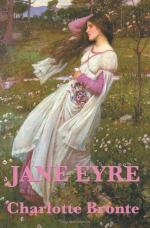|
This section contains 375 words (approx. 2 pages at 300 words per page) |
Jane Eyre: A Gothic Novel?
Gothic literature, as defined by Wikipedia Encyclopedia, "is a style of fiction that emphasizes the grotesque, mysterious, and desolate." Examples of Gothic writers are Hawthorne, Poe, Dickens and Charlotte Bronte. Charlotte Bronte's novel Jane Eyre is a perfect example of a Gothic Novel.
"The conventions [of a Gothic novel] include wild and desolate landscapes; ancient buildings such as ruined monasteries, cathedrals, and castles with dungeons, torture chambers, secret doors, and winding stairways; apparitions such as phantoms, demons, and necromancers; an atmosphere of brooding gloom; and youthful heroines who face off against corrupt aristocrats, wicked witches, and hideous monsters (Wheeler)." Published in 1847, Bronte's novel of a orphan seeking her place in life, provides all these elements that define a Gothic Novel, as well as many others including "a heroine of trembling sensitivy[sic] with an impetuous lover and a tyrannical older man (Wikipedia)" which role Bronte fills using the character of Mr. Rochester. Also, "its typical settings include gloomy castles, oppressive ruins in wild landscapes (Wikipedia)", both of which Bronte utilizes in her settings of Thornfield, Lowood and the moors.
But more importantly in defining a Gothic Novel, is the tone in which the novel is written. The tone of a Gothic Novel is often reflects the desolate and reflective state of its main subject (Wheeler). Bronte's novel indeed does reflect the bleak and pensive thoughts of Jane. In fact, Bronte depicts Jane as saying, "Nature seemed to me benign and good; I thought she loved me, outcast as I was; and I, who from man could anticipate only mistrust, rejection, insult, clung to her with filial fondness. (350)" The message the novel seems to send is that love and pain are inexplicitly connected. Although it may seem that this preoccupation with the austere and foreboding might have a negative effect on the reader, it does the exact opposite. The reader becomes enthralled by the mystery, enraged by the lies and misfortunes, and shocked by sudden turn of events.
WORKS CITED
Bronte, Charlotte. Jane Eyre. Bantam Classics: New York, New York. 1847.
Wheeler, Kip. Literary Devices. Literary Devices: G. February 23, 2006.
http://web.cn.edu/kwheeler/lit_terms_G.html
Wikipedia: the Free Encyclopedia. Gothic Novel. 2006
en.wikipedia.org/wiki/Gothic_literature
|
This section contains 375 words (approx. 2 pages at 300 words per page) |


